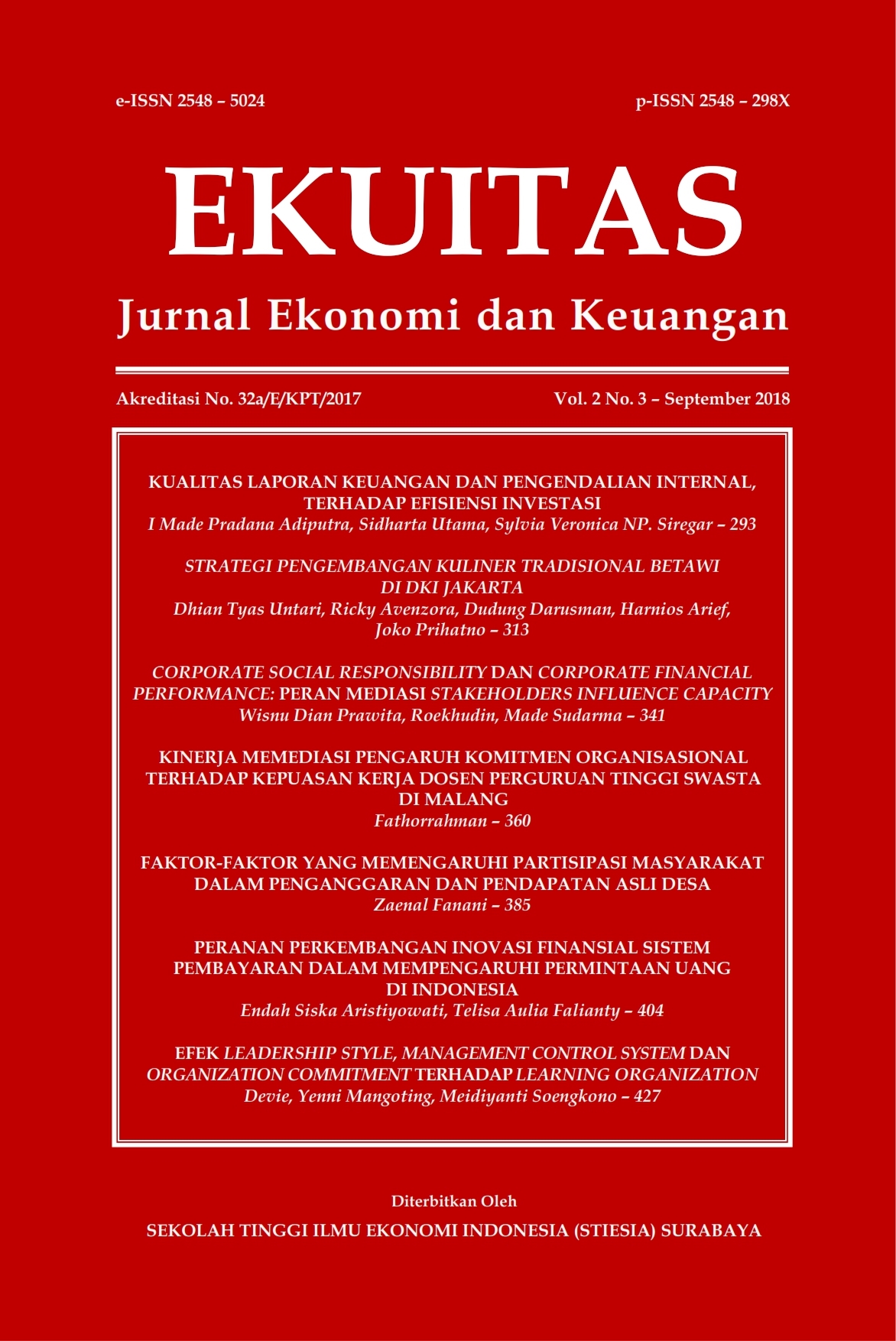PERANAN PERKEMBANGAN INOVASI FINANSIAL SISTEM PEMBAYARAN DALAM MEMPENGARUHI PERMINTAAN UANG DI INDONESIA
DOI:
https://doi.org/10.24034/j25485024.y2018.v2.i3.128Keywords:
financial innovation, money demand, currency, payment systemAbstract
This paper examines the dynamic interaction between financial innovation development in the payment system to money demand function especially for currency and narrow money, from 2007-2017 using Indonesia monthly data. This research based on Baumol (1952) and Tobin (1956) and Lippi and Secchi (2009) theory which stated that improvement of technology in the payment system will lead to a decrease in transaction demand for money. From estimation result using Vector Error Correction Model (VECM) method, study reveals that tremendous development in the payment system on the last eleven years i.e Real Time Gross Settlement, Clearing, Automatic Teller Machine (ATM)atauDebit Card, Credit Card and electronic money using several proxies, such as using transaction value (with and without clearing), total transaction value, transaction volume, ratio of financial innovation in the payment system to Gross Domestic Product (GDP), broad money (M2) to narrow money (M1) ratio, ratio of financial innovation in the payment system to narrow money (M1) will decrease currency and narrow money (M1). Analysis of the financial innovation in the payment system role in affecting money demand (currency and narrow money) is very important so that money demand function is not misspesificied and in determining monetary policy has considered the development of payment system technology.
References
Akhand, H. dan R. Milbourne. 1986. Credit Cards and Aggregate Money Demand. Journal of Macroeconomics 8: 471–478.
Aliha, P. M. 2017. Investigating the Effect of Financial Innovation on the Demand for Money in Malaysia Using the ARDL Approach to Cointegration. Regional Science Inquiry IX(1): 177-193.
Alvarez, F. dan F. Lippi. 2009. Financial Innovation and The Transactions Demand for Cash. Econometrica 77: 363–402.
Attanasio, O. P., L. Guiso, dan T. Jappelli. 2002. The Demand for Money, Financial Innovation, and The Welfare Cost of Inflation: an Analysis With Household Data. Journal of Political Economy 110: 317–351.
Arrau, P. dan J. D. Gregorio. 1993. Financial Innovation and Money Demand: Application to Chile and Mexico. The Review of Economics and Statistics 75(3): 524–530.
Arrau, P., J. D. Gregorio, C. Reinhart, dan P. Wickham. 1995. The Demand for Money in Developing Countries: Assessing the Role of Fnancial Innovation. MPRA Paper 14096: 1-30.
Baba, Y., D. F. Hendry, dan R. M. Starr. 1992. The Demand for M1 in The U.S.A., 1960-1988. Review of Economic Studies 59: 25-61.
Baumol, W. J. 1952. The Transactions Demand for Cash: An Inventory Theo- retic Approach. Quarterly Journal of Economics 66: 545–556.
Bordo, M. dan L. Jonung. 1987. The Long-Run Behavior of the Velocity of Circulation: The International Evidence, Cambridge, University Press.
Carbo-Valverde, S., F. Rodriguez-Fernandez. 2014. ATM Withdrawals, Debit Card Transactions at The Point-of-Sale and The Demand for Currency. SERIEs 5: 399–417.
Cho, D. dan W. Miles. 2007. Financial Innovation and The Stability of Money Demand in Korea. Southwestern Economic Review: 51-59.
Columba, F. 2009. Narrow Money and Transaction Technology: New Disaggre- gated Evidence. Journal of Economics and Business 61: 312–325.
Daniels, K. N. dan N. B. Murphy. 1994. The Impact of Technological Change on The Currency Behavior of Households: an Empirical Cross-Section Study. Journal of Money, Credit and Banking 26: 867–874.
David, B., A. François, dan P. Waelbroeck. 2016. Debit Card and Demand for Cash. Journal of Banking and Finance 73: 55–66.
Duca, J. V. dan W. C. Whitesell. 1995. Credit Cards and Money Demand: A Cross-sectional Study. Journal of Money, Credit and Banking 27(2): 604-623.
Fischer, A. M. 2007. Measuring Income Elasticity for Swiss Money Demand: What do the Cantons Say About Financial Innovation?. European Eco- nomic Review 51: 1641–1660.
Fujiki, H. dan C. B. Mulligan. 1996. A Structural Analysis of Money Demand: Cross-Sectional Evidence From Japan. Bank of Japan Monetary and Economic Studies 14: 53–78.
Handa, J. 2009. Monetary Economics. 2nd edition. Routledge Taylor & Francis Group. New York.
Nagayasu, J. 2012. Financial Innovation and Regional Money. Applied Economics 44(35): 4617-4629.
Lieberman, C. 1977. The Transactions Demand for Money and Technological Change. Review of Economics and Statistics 59: 307–317.
Lippi, F. dan A. Secchi. 2009. Technological Change and The Households Demand for Currency. Journal of Monetary Economics 56: 222–230.
Milbourne, R. 1986. Financial Innovation and The Demand for Liquid Assets: Note. Journal of Money, Credit and Banking 18 (4): 506–511.
Mulligan, C. B. dan X. Sala-i-Martin. 1992 US Money Demand: Surprising Cross-Sectional Estimates. Brookings Papers on Economic Activity 2: 285–329.
Oyelami, L. O. dan D. O. Yinusa. 2013. Alternative Payment Systems: Impli- cation For Currency Demand and Monetary policy in Developing Economy: a Case Study of Nigeria. International Journal of Humanities and Social Science 3(20): 253-260.
Pramono, B., T. Yanuarti, P. D. Purusitawati, dan Y. T. Emmy. 2006. Dampak Pembayaran Non Tunai Terhadap Perekonomian dan Kebijakan Moneter. Working Paper Bank Indonesia 11: 1-60.
Rinaldi, L. 2001. Payment Cards and Money Demand in Belgium. CES Discussion Paper DPS 01.16. KU Leuven.
Sahabat, I. 2009. Pengaruh Inovasi Sistem Pembayaran Terhadap Permintaan Uang di Indonesia. Tesis. Program Pascasarjana Ilmu Ekonomi, Universitas Indonesia. Jakarta.
Syarifuddin, F., A. Hidayat, dan T. Tarsidin. 2009. Dampak peningkatan pembayaran non-tunai terhadap perekonomian dan implikasinya terhadap pengendalian moneter di Indonesia. Buletin Ekonomi Moneter dan Perbankan 11(4): 369-402.
Shiva, R. K. dan R. K. Durai. 2017. Impact of Credit Cards and Debit Cards on Currency Demand and Seigniorage: Evidence from India. Academy of Accounting and Financial Studies Journal 21(3): 1-15.
Stix, H. 2004. How Do Debit Cards Affect Cash Demand? Survey Data Evidence. Empirica 31: 91–115.
Tobin, J. 1956. The Interest Elasticity of Transactions Demand for Cash. Review of Economics and Statistics 38(3): 241–247.
Tufano, P. 2003. Financial Innovation. The Handbook of the Economics of Finance. North Holland. Boston.
Yazgan, M. E., dan H. Yilmazkuday. 2009. The Effects of Credit and Debit Cards on the Currency Demand. Applied Eco- nomics 41(16): 2115–2123.














